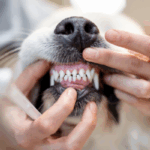Fears, Phobias and Anxieties
Fear is a physiologic, behavioral and emotional reaction to stimuli that an animal encounters. Physiological reactions include increased heart rate, increased respiratory rate, sweating, trembling, pacing and possibly urination and defecation. Behavioral changes will include change in body posture and activity. The animal may engage in an avoidance response such as fleeing or hiding. If they animal perceives a threat, the response can also include animals of defensive aggression. Observation of body postures and facial expressions can tell you if an animal is afraid.
 Anxiety VS Phobia
Anxiety VS Phobia
Anxiety is a diffuse feeling of impending danger or threat. Anxiety is manifested by some of the physiologic signs of fear, but also may be displayed as displacement or redirected behaviors, destructive behaviors or excessive vocalization.
Phobia is an intense response to a situation that the animal perceives as fear-inducing. Common phobias in animals involve noises and places.
Triggers for these behaviors are as varied as there are breeds of dogs. Animals may be frightened of people, other animals, places or things. Others may only respond with fear or phobia in one particular situation such as a thunderstorm.
Sometimes fear in the result of an early experience that was unpleasant or perceived by the animal as unpleasant. Phobic responses can occur from just one exposure or gradually increase over continued exposure
A good program of socialization and exposure to many new and novel things while an animal is young are helpful and often prevent fears and phobias. However, in the phenomena of ‘one trial’ learning, an even is so traumatic that only one exposure can create fears, phobias or anxieties. Calm reassurances as long as the pet is not acting fearful, happy cheerful tones, and relaxed body postures of owners help pet experience new things without fear. Knowing your pet and its temperament will also determine what situations you can and should expose your pet to.
Each time your pet is exposed to an anxiety, fear or phobia inducing situation and cannot be made to calm down, the problem is likely to worsen. Finding a way to control, relax, calm or distract your pet in the presence of the stimulus is needed to correct the problem, and teach your pet there is nothing to be feared. An owner who is calm, confident and in control reduces the fear and anxiety associated with new stimuli and situation. Expose your pet to mild levels of the stimuli and reward him/her for remaining calm and not expressing fearful behavior. Your pet should calm down with continued exposure, as long as nothing is done to aggravate the fear.
Punishment in close association with exposure to a stimulus may further cause fear and anxiety towards the stimulus.
Drug therapy may also be useful adjunct to behavior therapy techniques and may be necessary in the treatment of some phobias.
If you are worried about your pets response to noises, places or people, call us today on 9878 3033 to book a behavioral consult with one of our experiences veterinarians.





